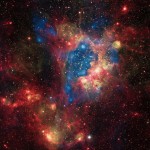By Maria Papanikolaou (B class)
Einstein’s general Theory of Relativity predicted that space-time began at the big bang singularity and would come to an end. At the beginning, the universe is thought to have had zero size, and so to have been infinitely hot. However, as the universe expanded, the temperature of the radiation decreased. One second after the big bang, it fell to about ten thousand million degrees. At that time, the universe contained mostly photons, electrons, and neutrinos and their antiparticles, together with some protons and neutrons. As the universe continued to expand and the temperature to drop, most of the electrons and antielectrons annihilated with each other to produce more photons, leaving only a few electrons. About one hundred seconds after the big bang, the temperature fell to one thousand million degrees. At this temperature, protons and neutrons started to combine to produce the nuclei of atoms of deuterium, which contain one proton and one neutron. The deuterium nuclei then combined with more protons and neutrons to make helium nuclei, and small amounts of a couple of heavier elements. Protons and neutrons converted into helium nuclei, along with a small amount of heavy hydrogen and other elements. The remaining neutrons decayed into protons, which are the nuclei of ordinary hydrogen atoms.
After millions of years, electrons and nuclei started combining to form atoms. The universe as a whole continued expanding and cooling, but the expansion slowed down by the extra gravitational attraction. This eventually stopped expansion in some regions and caused them to start to re-collapse. Eventually, when the region got small enough, it was spinning fast enough to balance the attraction of gravity, and in this way, disk-like rotating galaxies were born.
As time went on, the hydrogen and helium gases in the galaxies broke up into smaller clouds that collapsed under their own gravity. As these contracted, and the atoms within them collided with one another, the temperature of the gas increased. These converted the hydrogen into more helium, and the heat given off raised the pressure, and so stopped the clouds from contracting any further. They remained stable in this state for a long time as stars. The earth was initially very hot and without an atmosphere. In the course of time, it cooled and acquired an atmosphere from the emission of gases from the rocks. This early atmosphere was not one in which we could have survived. There are, however, other primitive forms of life. It is thought that they developed in the oceans, possibly because of chance combinations of atoms into large structures, which were capable of assembling other atoms in the ocean into similar structures. They thus reproduced themselves and multiplied. In some cases, there were errors in the reproduction. Mostly these errors were such, that the new macromolecule could not reproduce itself and eventually was destroyed. However, a few of the errors produced new macromolecules that were even better at reproducing themselves. They therefore had an advantage and tended to replace the original macromolecules. This way a process of evolution started that led to the development of more and more complicated, self-reproducing organisms. The first primitive forms of life consumed various materials, including hydrogen sulfide, and released oxygen. This gradually changed the atmosphere to the composition that it has today, and allowed the development of higher forms of life.
In an expanding universe in which the density of matter varied slightly from place to place, gravity caused the denser regions to slow down their expansion and start contracting. This led to the formation of galaxies, stars, and eventually even insignificant creatures like us. Thus, all the complicated structures that we see in the universe can be explained by the no-boundary condition of the universe together with the uncertainty principle of quantum mechanics. So, what if the universe is really completely self-contained, having no boundary or edge, it would have neither beginning nor end: would it simply be?
Sources:
A Brief History of Time, by Stephen Hawking



